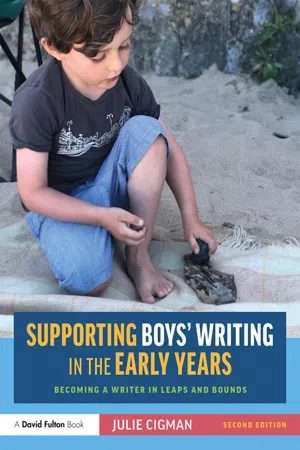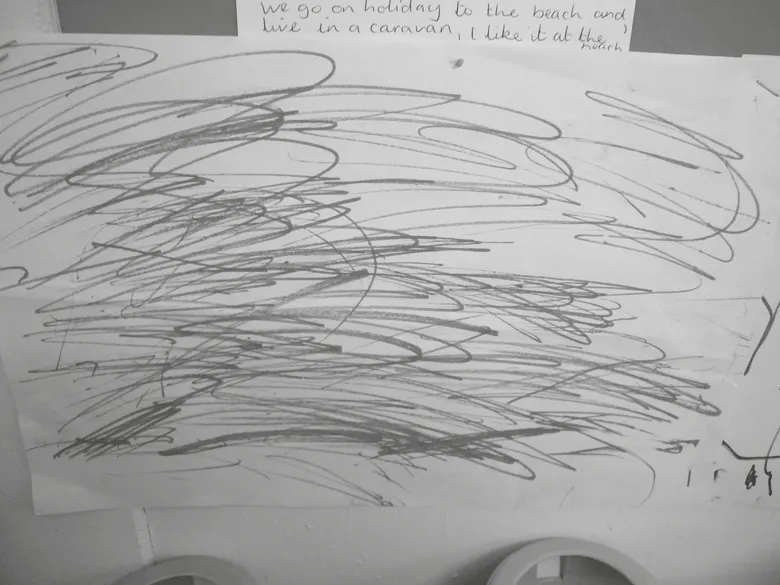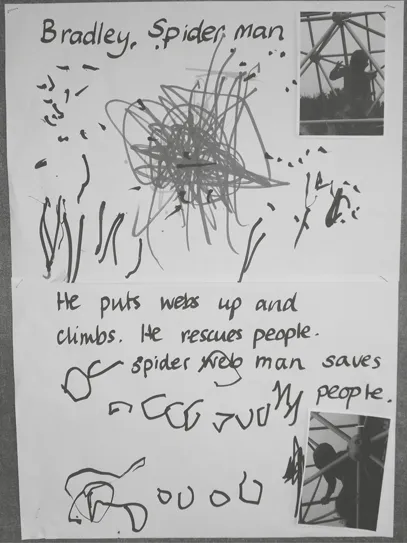![]()
Daisy, aged 2, clambers up onto a chair at the kitchen table and picks up a pencil. She gives a deep sigh, lowers her head and starts to make marks on some paper. Her mother looks up, surprised, then realises that Daisy is copying the tense posture that she often has when she writes.
George, aged 4, holds his drawing above his head and says: ‘Who wants this? Someone who’s been very good today!’
Learning to write is vital if we are to take part successfully in the adult world. When we are at ease with the written word, we can gather and retain ideas and information, we can create and enjoy stories and communicate simple and complex messages with others. But the importance of writing isn’t obvious to very young children. They learn how to ‘join the literacy club’ (Smith, 1988) by interacting with positive, caring role models who are already part of the club: family members, friends and people in the community who write for all kinds of purposes as part of their working and home life.
By the time children start school, they will have absorbed attitudes to writing from their early experiences, and they will reflect back at the world the positive and negative experiences that have been presented to them. Early literacy provision can only be effective if it allows children to gain a positive view of themselves as writers while they acquire the necessary skills to communicate through writing.
This chapter describes the stages that children move through in learning to write: and it presents a developmentally appropriate approach to early writing that allows every child to develop a voice as a writer while they learn the skills of writing, from their initial mark making, to the start of conventional spelling.
What does early writing look like?
When Amie started in her Reception class, she could recite the alphabet confidently and she loved spending time at the writing table, filling sheets of paper with neatly formed letter shapes copied from the alphabet chart. Her mother was very proud of the ‘work’ that she brought home at the end of the day. When her teacher sat with Amie and gently encouraged her to talk about her writing, Amie was unresponsive. For Amie, the enjoyment was in creating the shapes and patterns on the page, and having her mother’s approval. She hadn’t yet understood that writing was a way of communicating a message and she hadn’t made the connection between the alphabet that she could chant with the letters that she could write on the page.
Jack spends most of his time in the Reception class outside, playing games connected with space travel. He is fascinated by meteorites and often brings books about space travel to school. He creates complex play narratives with his friends, involving conflicts that he resolves, with aliens and other space travellers.
Who is the better writer, Amie who produces pages filled with well-formed letter shapes, or Jack, who doesn’t choose to write on paper, but is articulate and imaginative and who can create all of the elements of a story orally and dynamically?
Early experiences
In order to become a writer, children must develop transcriptional skills of handwriting, spelling and punctuation; and they must develop compositional skills, by finding a creative and expressive voice of their own through which they can communicate using the transcriptional skills of writing.
The foundations of writing are in spoken language. Children who have rich experiences of oral language absorb the rhythms and patterns of everyday speech and learn the language of stories, rhymes and songs. They learn to express their thoughts, ideas and feelings orally and to enter into other worlds.
Children can start to develop a voice of their own as a writer from very young, in the company of caring adults who listen to their voice and encourage them to express themselves.
Imaginative play
Small world play and role play areas offer spaces where children can use language in play contexts that link to the real world and where they can engage in symbolic play as a precursor to writing. As they begin to understand that writing is a way of recording language in a symbolic form, they can mark make and write in contexts that have intrinsic meaning for them. At the same time, role play supports communication and language skills, social development and collaborative play.
When children play with small world characters and engage in role play they are beginning to create stories.
Sophia, aged 2 years and 10 months, is using language to develop her thinking and to make sense of her world as she plays with cars at the kitchen table.
Vroom, vroom, vroom, vroom … (She shunts the cars)
Hallo! Look at my handstand. (The two cars are talking to each other)
Look dad. Come play with me. Dad! Daddy car, look! Daddy car, come play with me.
Having a bath! (She puts the car in a cup of milk)
One car called Dylan, one called mummy, one called daddy.
Slurp, slurp, slurp! (She feeds the car, singing)
Sophia’s use of private speech (Vygotsky, 1962) allows us to see that she has created characters for the cars based on her family (Dylan is her little brother) and she is acting out the familiar events of meal times, bath times and play with Daddy. Within a few years, Sophia’s private speech will become internalised as thought or ‘inner speech’, and as she grows older, she will be able to create stories and compose her thoughts internally. In university libraries, adults can read and write in silence. In Early Years classrooms, a quiet space is unproductive. Young children need to use language to think and learn.
Playing with songs, rhymes and stories
Adults can help children to develop a writer’s voice by reading the same stories and singing the same songs repeatedly. When adults and children play with stories, songs and rhymes, using familiar structures to create new versions by changing some of the words, this shows children that they can be authors, poets and songwriters. Playing with stories, songs and rhymes helps children to develop phonological awareness: the ability to tune into the sounds and patterns of oral language that will enable them to learn the letter–sound (grapheme–phoneme) correspondences that we use to read and write.
Scribing
When adults scribe children’s words as they draw or play, or while they make cards for friends and family, children begin to see the connection between their oral language and the conventions of written language. They are now becoming members of the ‘literacy club’.
The transcriptional skills involved in writing will inevitably come later than compositional skills. Children start to make a connection between sounds they hear and the symbolic representation of these sounds when they see writing modelled by adults in contexts that make sense to them and when they become aware of everyday environmental print: writing around them at home, in shops and in the street.
Children can engage in the whole act of writing before they understand the mechanics of spelling and punctuation, when they give meaning to marks that look like writing in their play. But at some stage, the mechanics do need to be taught directly, when children are at the appropriate stage of development to make sense of a symbolic system. We can only support children to make progress through the developmental stages of transcriptional writing if we fully understand what these stages look like.
Developmental stages of transcriptional writing
1.Mark making
There’s no trees, trees don’t be at beaches. Umm, sometimes I fall over and the waves goes over me, but we don’t have clothes on for that, we just have swimming costumes on. We go on holiday to the beach and live in a caravan, I like it at the beach.
Owen’s mark making is confident and free-flowing. He talks expressively to an adult about his mark making, describing a complex scene. At this stage, his marks don’t resemble writing, but he appears to enjoy the sensation of making marks on paper.
30 to 50 months
•Sometimes gives meaning to marks as they draw and paint.
Development Matters, Early Education (2012)
2.Mark making that looks like writing, with some individual letter-like shapes


